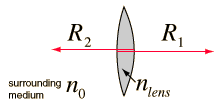Simple:
Thick lenses can be handled with thin lens type equations if the distances are measured from hypothetical principal planes. The power of a lens with respect to the second principal plane H2 is given by Gullstrand's Equation:

The focal length f with respect to that second principal plane is given by:

Forms of Gullstrand's Equation are applicable to both separated lenses and to single thick lenses. Since Gullstrand powers and focal lengths are measured with respect to a hypothetical plane, it is often more useful to deal with front and back
OR
Lens-Maker's Formula
For a thin lens, the power is approximately the sum of the surface powers.

The radii of curvature here are measured according to the Cartesian sign convention. For a double convex lens the radius R1 is positive since it is measured from the front surface and extends right to the center of curvature. The radius R2 is negative since it extends left from the second surface.

For a lens in air which has index of refraction n =
with surface radii R1 = cm and R2 = cm
the thin lens approximation of the power is P = diopters
which corresponds to focal length f = cm .
If the lens is in another medium, such as water, its lens strength will be diminished.
If the lens is in a medium of index n =
then the lens power will be diopters
and the corresponding focal length f = cm.
The above calculation is a single purpose calculation which returns the powers and focal lengths based on the values of the radii and indices of refraction. Substitute a number in any field and the calculation will be initiated. Default values will be entered for any unspecified parameter, but the index and radius values may be changed.
The second part of the calculation above shows the diminshed power of a lens in a medium other than air. This gives important insight into the role of the two lenses of the human eye. The cornea has the greatest power because light enters it from the air. The inner crystalline lens has much less refractive power because it is suspended in a water-like medium.
I haven't a clue what that all means but you might!
http://hyperphysics.phy-astr.gsu.edu/hb ... oclen.htmlWill























